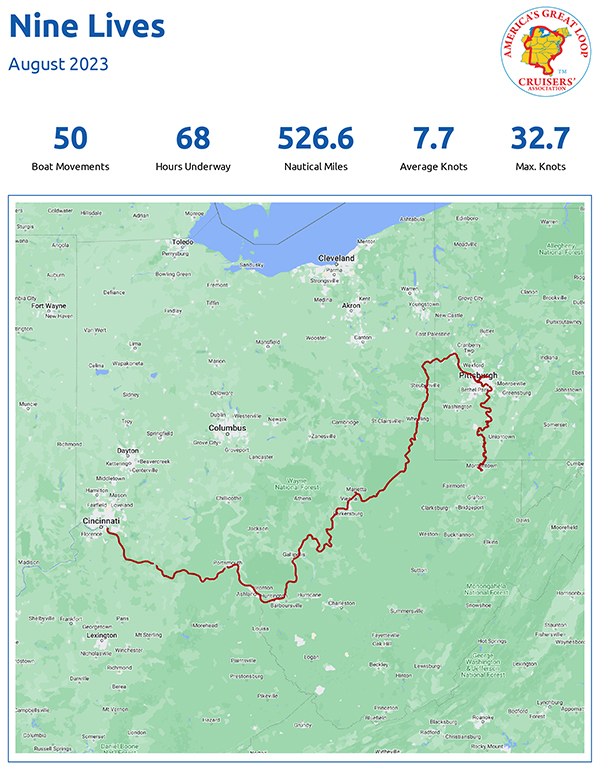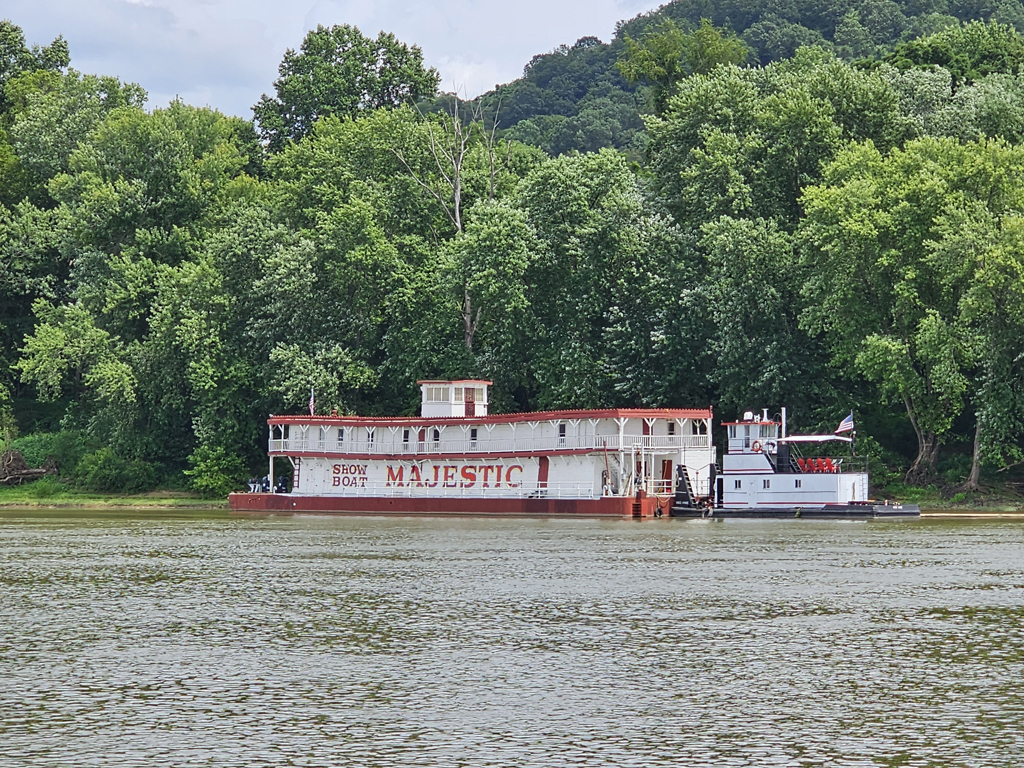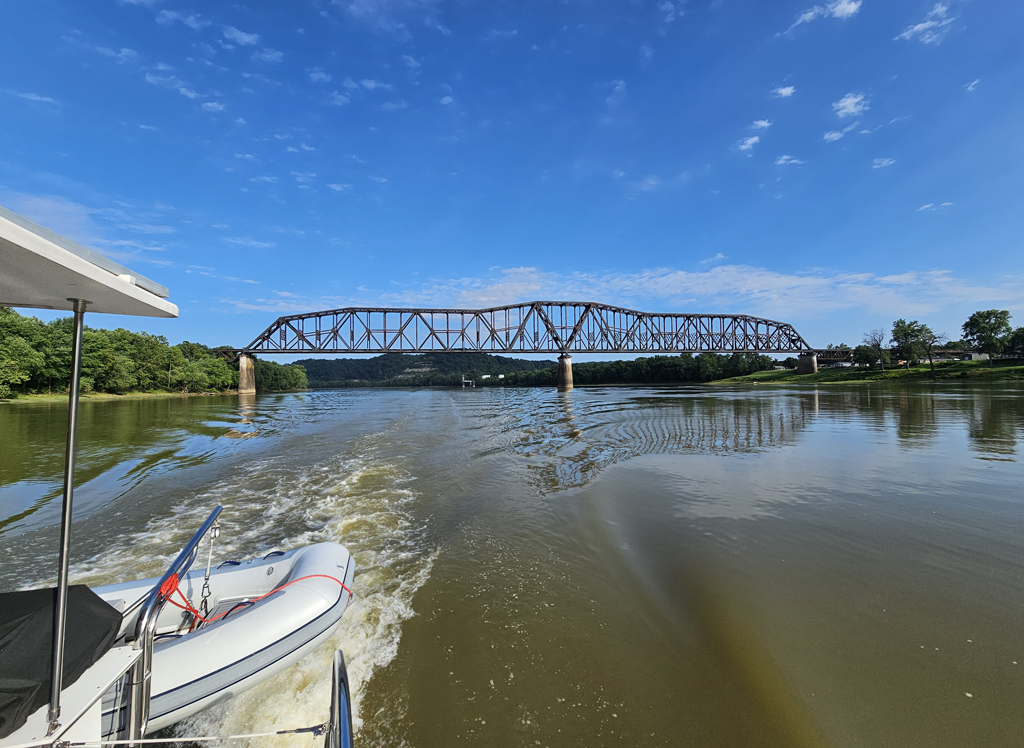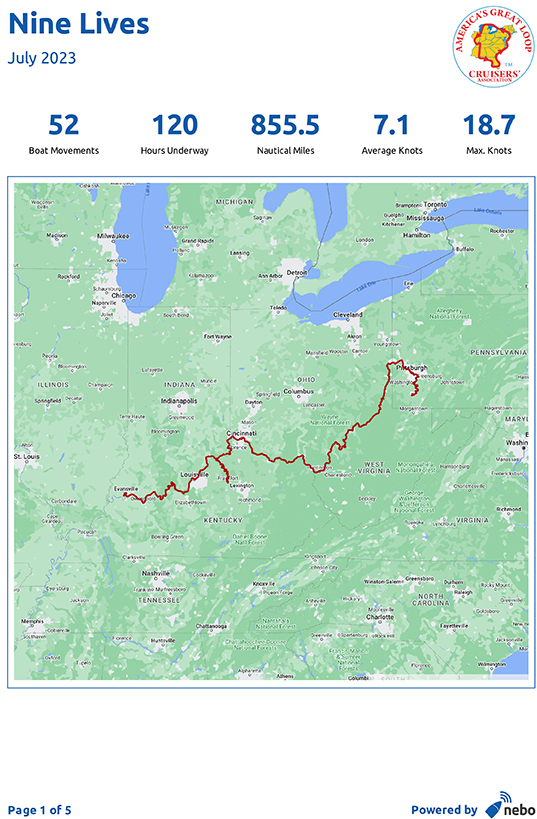Our departure from Pittsburgh was a little tricky. That morning, my slightly sore hip that began the evening before was much worse. Cause likely to be too much sitting still and not enough fluids the previous day. I was almost completely incapacitated, so Dick had to single-hand Nine Lives to the pump out machine. It was quite a challenge, with the strong current pushing us onto the dock, not to mention having to step carefully around the copious goose poop. The power pedestal ended up with a slightly greater lean than it already had (bad positioning, right on the edge of the dock and too close to the pump out machine, we were not the first to nudge it!) Apart from that, the maneuver was well executed. As we initially pulled away from our docking position, and turned around to come back to the pump out, I looked up and saw that we had an audience of about 10 construction workers from the high-rise going up above the waterfront, all standing at the railings watching us. Sometimes, you’re the audience, sometimes, you’re the show! Fortunately, we were out of their sight for the minor pedestal mishap.
By the time we arrived at the first lock of the day, I was able to drive the boat in as usual, and bring it to the wall for Dick to handle the long line. However, Dick had to do all my usual tasks with fenders, moving them and deploying them, as well as bringing them in after the lock. He got a small taste of what single-handing and/or a non-participating spouse would be like. (We have met a surprising number of Looper couples who divide up the responsibilities in such a way that the lady has almost no involvement in any aspect of boat handling, certainly that would never be our preference).
We passed the Shell Ethylene Cracker Plant. Dick said they were just completing this plant when he retired. It was built in Pennsylvania rather than Texas, because of all the cheap gas available from Utica and Marcella Shales fracking operations. It is good to see new industry on the Ohio, after so many abandoned and derelict factories.

We got through 3 locks and tied up in the marina in Chester, with Dick doing all the work except for maneuvering in the locks. Holiday Marina is a nice small marina, set in a basin off the river, so very little wakes to bother us. There is lots of grass, and several pavilions and grills for the use of boaters. It is also a small RV site, and has immaculate and spacious shower/rest rooms. We had been happy with our stay on the upbound journey.
As we sat enjoying the evening, one of the occupants of an RV made his way down to us and welcomed us back. He likes chatting with transient boaters, especially Loopers. In addition to offering to lend us a car to get groceries or run errands, he mentioned that he had hoped to invite us to breakfast on our last visit, but we had already left early that morning.
He told us an interesting story, that we had entirely missed because we were sitting facing away from the river. Earlier, he and his wife had seen a car sink near the shore across the other side of the Ohio River. The man’s wife called the police to report it, and got the story. Apparently, a couple had a snapping turtle in a cooler, that they were trying to release unharmed into the river. The man backed his SUV down to the water, and planned to gun the engine forward with the back open, so the cooler would open and the turtle fall into the water. Unfortunately, he mistakenly put the vehicle into reverse, and when he stamped on the accelerator, the SUV went straight backwards into the water at speed. It sank. Fortunately, the windows were open, so the couple were able to get out and swim to shore. No word on the fate of the turtle. Attempts to retrieve the vehicle by emergency services had not succeeded by the time it got dark.
We had plenty of time the next morning, with a short distance and only one lock, so Dick was busy with his computer when he discovered the sad demise of his HP41CX calculator. He had it for the better part of 40 years. It was working fine until the previous day when Dick reached behind him and it leapt off the shelf and down the stairs, a drop of about 6 feet. The landing proved to be too much for the venerable machine. Dick particularly liked that calculator for its sophisticated engineering functions. Not to mention that the Reverse Polish Notation method of use is so obscure (IMHO) that there was no possibility that his light-fingered wife would abscond with it! I offered him a basic solar powered calculator that I found in a cupboard, but it was soundly rejected in favour of using the one on his phone. R.I.P HP41CX.
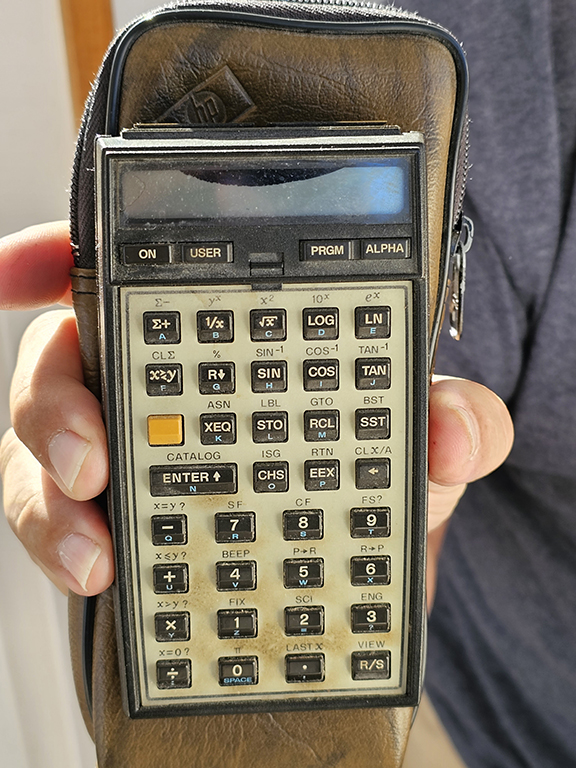
Once Dick recovered from his tragic loss, we set off for the day, still with Dick having to do all my line and fender handling jobs. Unfortunately, we arrived at the lock as it was being prepared for an up-bound tow, and there was a 15-barge tow just behind us, who had priority. Altogether, it took over 4 hours before we were through. It was our first real delay since we started on the Ohio and waited at our first lock for 4 hours, so we can’t complain. Most of the Ohio locks have two chambers, a large one and a smaller one. We are generally put through the small chamber, and usually with no delay, but at this lock the small chamber is out of operation. We have heard that the last two locks we will encounter on the Ohio are using only their small chamber while the large ones undergo repairs. This will likely mean very long delays for us, as the tows will have to split to go through, and thus will take twice as long. We use an app called Nebo. It has various useful functions, including allowing anyone to track us or see where we are at any given time. We have a device installed on Nine Lives, that automatically starts tracking when it senses motion. This is designated as a “journey”, and it ends the journey when we stop. Our Nebo track for the day showed an amusing number of stops, as Dick maneuvered and held position in front of the lock while we waited for our turn.

I have been noticing that all summer we have been passing loaded barges with coal, going in both directions. This day, we saw some loaded barges with a clear difference in the piles of coal. Dick tells me that there are several kinds of coal, but in this country the two most used are bituminous, and anthracite. Bituminous coal is common coal used in power plants, while anthracite is a harder coal, considered a metallurgical coal, and is typically used in steel manufacture. Anthracite is the highest quality, and has fewer impurities, which is important for use in steel making.

We passed through Wheeling, with its historic bridge. For a short time, it was the largest suspension bridge in the world. When it was built in 1849, it was the first bridge to cross a major river west of the Appalachians. A bridge to cross the Ohio River and connect the important National Road (also known as the Cumberland Road) was first proposed in 1816, but it took many years before a bridge was actually built. Different cities wanted a bridge, the federal government didn’t want to fund it, and neither did any of the states. By 1847, with mail being lost and commerce disrupted, Ohio and West Virginia agreed to approve a suspension bridge. It was immediately controversial, because the steamboats that carried goods and passengers up and down the Ohio had tall smokestacks, that were continually increasing in height. By 1849 the objections reached the Supreme Court, with lawyers for Pennsylvania claiming that the new bridge was a nuisance that obstructed commerce on the river. At the time, there was considerable dispute over whether river transport was a federal or a state matter. By 1850, when the case was finally heard, the Court refused to require the bridge to be torn down, instead it ordered that the height above the water be raised to 118 feet. The bridge company was allowed to “study” the concept of a removable portion rather than attempting to raise the entire bridge. Arguments, court cases, and accusations continued after the bridge deck was destroyed during a windstorm in 1854. It was rebuilt in spite of injunctions. Ultimately, it became a non-issue, as the increasing power of the railroads destroyed the steamboat business, and the Federal government found that having bridges over major rivers was in its favour, both for mail delivery, and for movement of military supplies and troops. Because the bridge was designed for horse and buggy traffic, it is unable to safely handle the weights of modern-day vehicles, whether it be volume of car traffic, or heavily loaded trucks. Attempts were made to limit weight on the bridge, but drivers continuously ignored the limits. For this reason, the bridge was closed to vehicular traffic in 2019. It remains open to pedestrians and cyclists, and will be preserved due to its historic importance. As we passed under it, we could see that it is currently undergoing renovations.
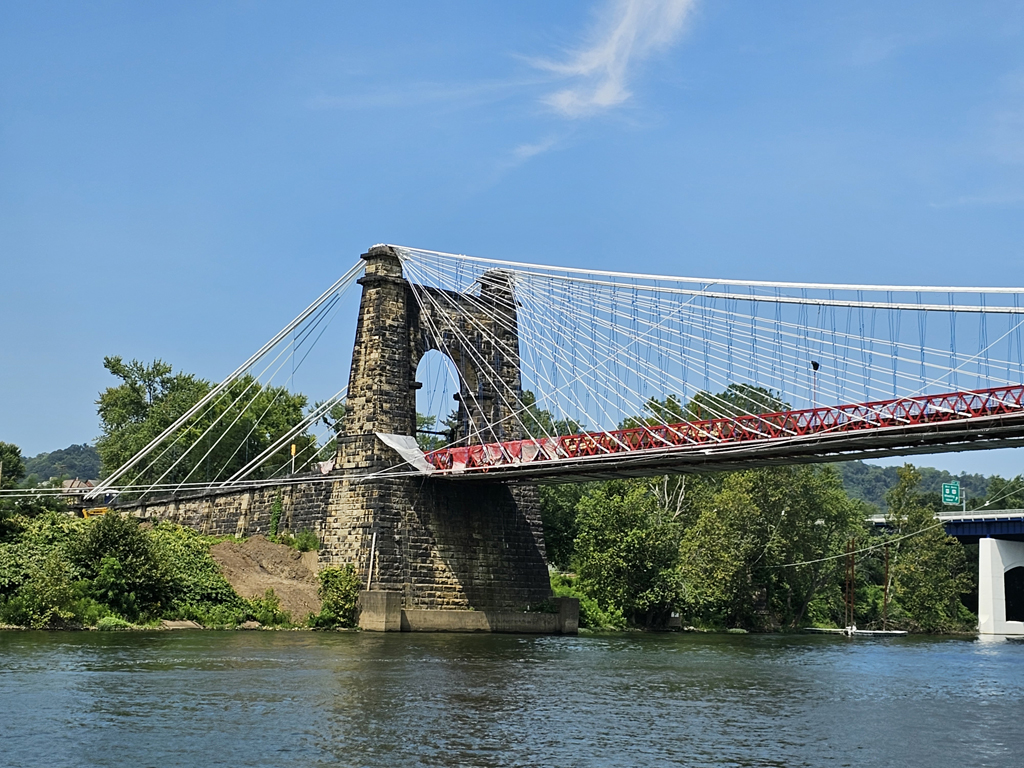
Last month, when we were northbound, passing Weirton, a fellow in the marina hailed us on the radio and invited us to stop there. As Dick prepared the itinerary for our return trip, he couldn’t find a phone number or email address, so we just cruised close to the docks and called out to a member who was there working on his boat. He made a phone call, and we were all set, with power and water as well! After giving us time to get settled, Steve came on board for some beer and chat. In due course we were joined by his wife and also his mother. I got out cheese and charcuterie, and made it a proper docktails. Later the commodore and his son the dockmaster dropped by as well to welcome us. It was a delightful evening, and we hope to see Steve and his wife in a few years on the Loop in the trawler he is currently restoring.
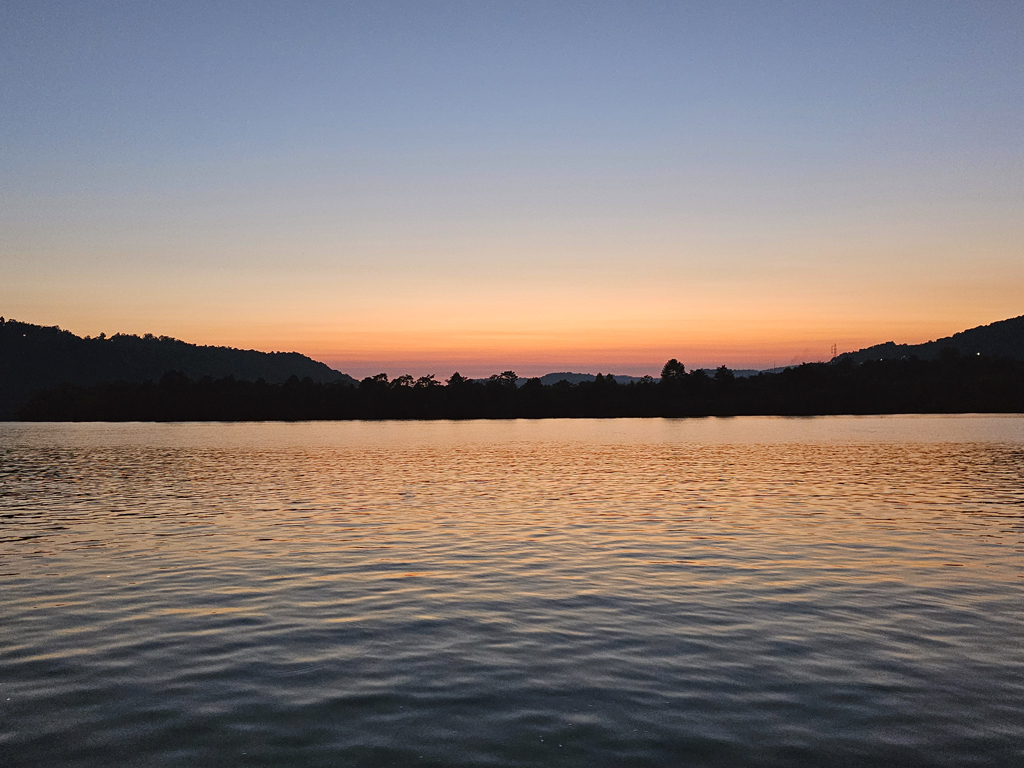
I have discovered an interesting thing about the Ohio River. Notwithstanding the name, and contrary to normal usage when a river forms the border between states, no part of the Ohio River belongs to Ohio. This has been a matter of debate since the 1700s, with the most recent challenge from Ohio in 1980 (they lost again). In 1783, the Ohio River was fully within the commonwealth of Virginia, which encompassed the land as far west as what is now Illinois and north to Wisconsin, including all of today’s Ohio, West Virginia, and Kentucky. In 1784, Virginia ceded its territory that was “to the northwest of the river Ohio”, but not any of the river, with the boundary being the low-water mark on the western bank of the Ohio River. This border was made under the Articles of Confederation, and carried over under the Constitution. Ohio tried to take some of the river when it became a state, by claiming that the state boundary should be in the middle of the river (as it is in most states where the border is a river). However, the Supreme Court ruled against them. Ownership of the River transferred to West Virginia, when they seceded from Virginia, and when Kentucky became a state, it also got its part of the River. Even when the River changed its route, moving north into Ohio, the state lost a claim to change the boundary. Still today, if you fish from the Ohio side of the river, you must follow West Virginia fishing regulations, or those of Kentucky. I find myself wondering about other things, like docks, that extend into the river, whether property owners need permission from Kentucky or West Virginia. Not to mention using river water for various industrial or agricultural purposes.
We passed the Cardinal Power Plant, planned to be converted to natural gas by 2030. Next door is a fly ash plant. Cardinal was ordered by the EPA to stop storing fly ash in waste ponds (chemicals and metals leak into the river). Fly ash can be used in the manufacture of concrete.
There was no wait at the lock, and we were tied up at Prima Marina by 2pm. There was no power suitable for Nine Lives, and no water on the docks, but at $25 it was a reasonable charge for overnight dockage. The evening meal was decent, mostly basket food, hamburgers, and chicken dishes, with a few more upmarket choices. All the food was served piping hot, which I always appreciate in this country, and don’t always get. Dick’s broiled whitefish was a nice change, and I enjoyed a grilled ham and cheese sandwich.
We returned to the boat, and worked in the salon while we waited for the evening entertainment to begin. This was a local singer, playing guitar and harmonica. When we realized he had started, we followed our usual practice and sat in the cockpit with adult beverages, ready to enjoy the music. It was awful. After a truly dreadful composition of his own, the singer moved on to Jimmy Buffet b-sides. One would hope that someone being paid to entertain would show at least some skill with their guitar, and be able to sing in tune. Eventually we decided that we couldn’t stand the butchery of what are very nice songs and ballads, so we repaired to the salon.
At this point we realized that the cool weather, welcome though it was, did not work in our favour. With no need for air conditioning, we opened the hatches and windows for air flow, and were then treated to the so-called music we had escaped! The finale was an appalling version of Country Roads, the song that begins, “Almost heaven, West Virginia…” The poor man couldn’t come close to hitting the high notes. The set ended, then to our dismay, an impromptu singalong began, with the participating audience every bit as bad. We hope that our previous positive experiences with live music have not come to an end!
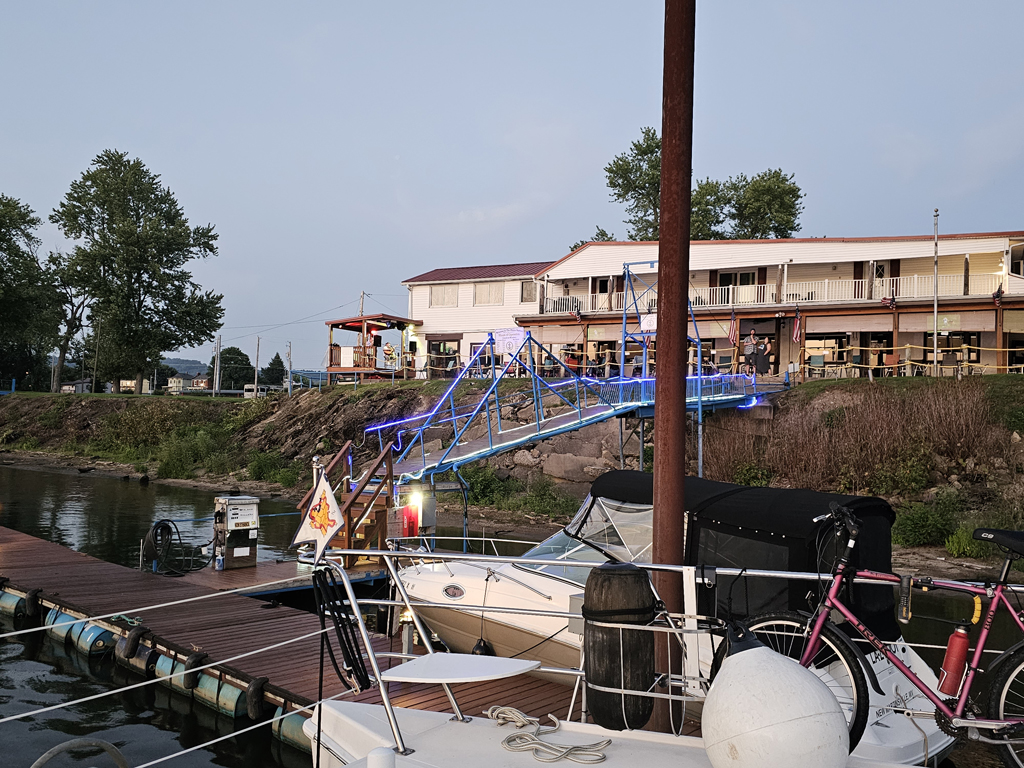
August 20. We passed the Marshall County Mine Barge Loading Facility, with the Mitchell Power Plant next door. I was amazed at the long, covered chute that carries the coal from the Powhattan Mine, situated well inland, to the docks.
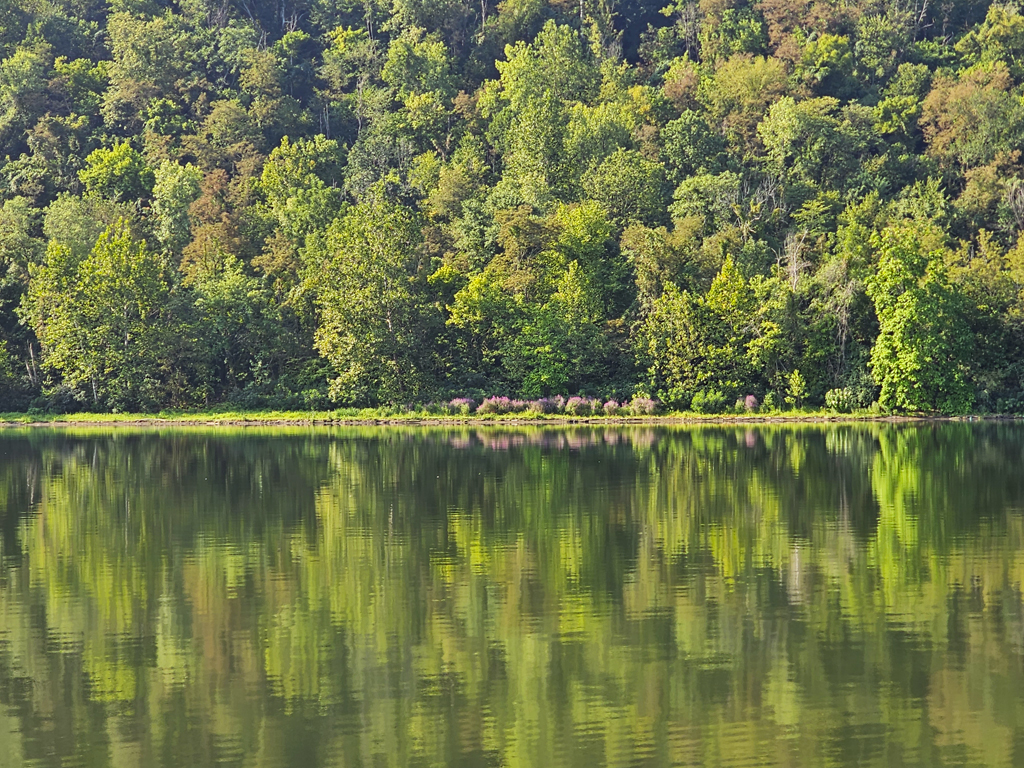

Bellaire Harbor Services was interesting, with a drydock and many tugs waiting for service, or possibly waiting for hire.

We had wondered several times about the lids that cover some of the barges. We could see that they were all the same, as the barges are standardized, but we couldn’t figure out how the lids would get onto the barges. At last, that small mystery was solved when we saw a crane with a special attachment placing lids onto a waiting barge.

It was a short day, leaving Prima Marina at 9:20 and tied up on the free town dock at New Martinsville by 1:15. This with a 30-minute delay for the lock. The town has very clean, wide docks, with good rubber and cleats. I was nervous because of the request that you advise the Police Department if you will be staying overnight. The only other place we have seen that is a notoriously unsafe stop on the Illinois. In fact, the clean docks and surroundings meant that, after all, I felt quite safe. We were out of sight of the streets, which probably also helped. Several pleasure boats docked for a while and people visited the town. We needed the generator for the first half of the night for air conditioning, but the outside temperature dropped enough that Dick could turn it off later and it was a very peaceful night.



The stop was only slightly marred by discovering in the morning, that the two teenage boys who had been fishing on the docks when we retired for the night, had left plastic bags, empty drinks bottles, and takeaway cartons on the end of the dock, ready to be blown into the river. Dick often picks up trash on docks and town walls. Young people accuse us of destroying their future with the use of fossil fuels, yet they are using the rivers as a trash dump for plastics that will never disappear, and are damaging the very fish they are trying to catch.
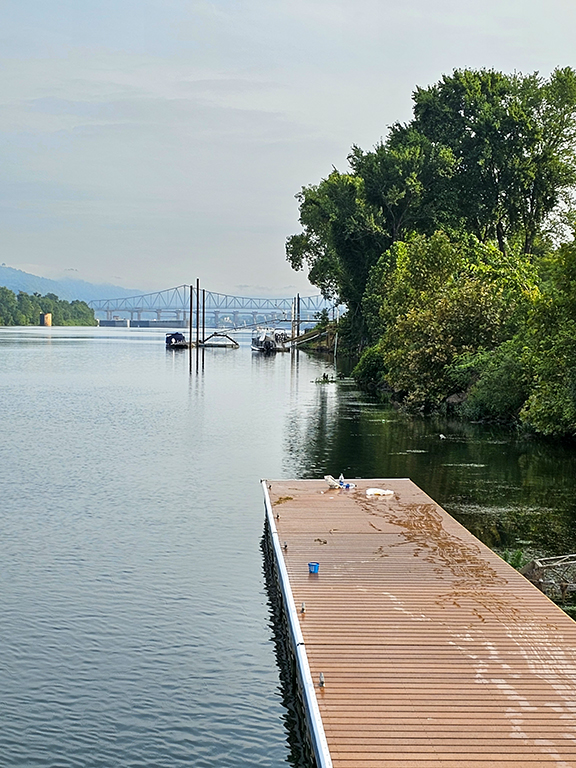
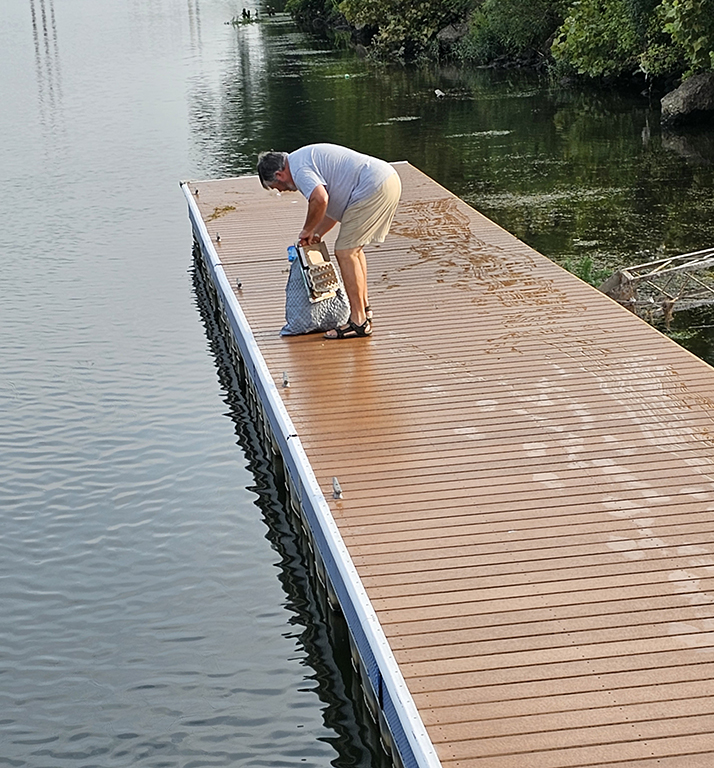
I learned that Western Pennsylvania’s version of the South’s y’all, or Southern Ontario youse, is yinz. Interesting!
We arrived at Marietta Boat Club by 1:45, but unfortunately, although we were expected, there was nobody to tell us where to dock. Our instructions had been to tie up at the fuel dock, and find somebody. It was hot, humid, and no breeze, so we had to run the generator. Eventually, we were able to move to a spot, but after we were tied up, we were told that a mistake had been made, and we would have to move after 2 nights. Once we were finally settled, we dropped the dinghy for the first time this season. The motor started immediately, such a difference from the old one!
We went to dinner by dinghy. The Boat Club is about a mile up the Muskingum River from the Ohio. There is a concrete dock on the Ohio at the foot of downtown. It was very hot and humid, so getting to the restaurant by dinghy was a lot nicer than riding bikes, even though there is a good bike path.
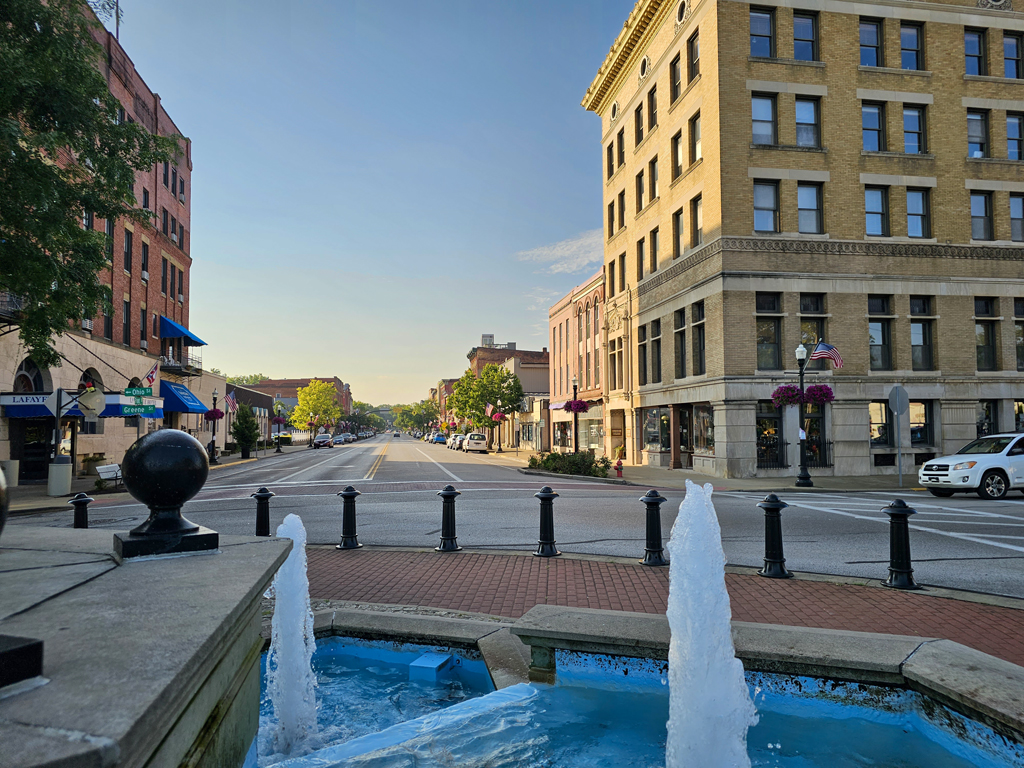
Austyns proved to be an excellent choice of restaurants. The food was a delicious combination of innovation and familiarity in a sort of Asian fusion style. We shared 2 appetizers. Prosciutto wrapped shrimp with a spicy remoulade sauce was very good. Spring rolls stuffed with glass noodles and crab were quite unique. Dick had a pasta dish with mixed seafood in a red pepper cream sauce with a filet of mahi mahi on top. I opted to try another starter instead of a main-sized course. Beef tips, marinated in truffle oil, and served in a delicious fondue of several cheeses was outstanding. For dessert, we shared an interesting Bailey’s chocolate cake that was just the right size, and not dreadfully sweet.





The next day was laundry day again. We have a Splendide washer/dryer on board. It is a typical European-sized machine, so with quite a small capacity compared to large American appliances. However, I don’t need to find a laundromat, deal with quarters, or schlepp laundry back and forth in hot, humid weather, as I would in marinas that have a facility. I can stay on the boat (or go out if I wish), and be comfortable instead of sitting in the laundromat. I find that once I sort the clothes, my loads are similar in size to what I would have at home –it’s only sheets and towels that I have to split into smaller amounts. The dryer is slow – a typical load takes 80 minutes on medium heat (the hot setting is too hot and will damage the fabrics). I hang most clothes to dry except socks and underwear anyway, so no difference in that respect from at home. There is always a debate among boaters, whether or not to look for a boat with a washer/dryer. I have noticed that most women tend to be in favour, while men (who, let’s be honest, are not usually the ones doing the laundry), are against. One does have to get over the idea of smaller loads and long drying times, but anyone I have met who has one, would never choose the laundromat again.

I carried on with the laundry while Dick prepared, and then recorded, a podcast he was asked to do for AGLCA about our trip up the Mississippi last year. The podcast is now available on U-Tube, and has been well received.
In the evening it was another pleasant dinghy ride to the dock at the foot of the town. The restaurant was quite a contrast to the previous evening. It was full, even thought it was Tuesday, but it was an entirely different demographic, with nobody I could see under 50-years old. The food was good, but not exceptional.
In the morning, we lost about 2 hours out of our day while we moved Nine Lives to a different spot on the docks. Since we had to untie anyway, we decided to do the pump out then, instead of the day we left. The pump out machine had some quirks, and Dick stood there for nearly half an hour thinking it was a very weak machine before discovering the technique for making it actually pump. We slid Nine Lives into her new, shorter, spot very professionally, sadly without anyone around to appreciate our skills.
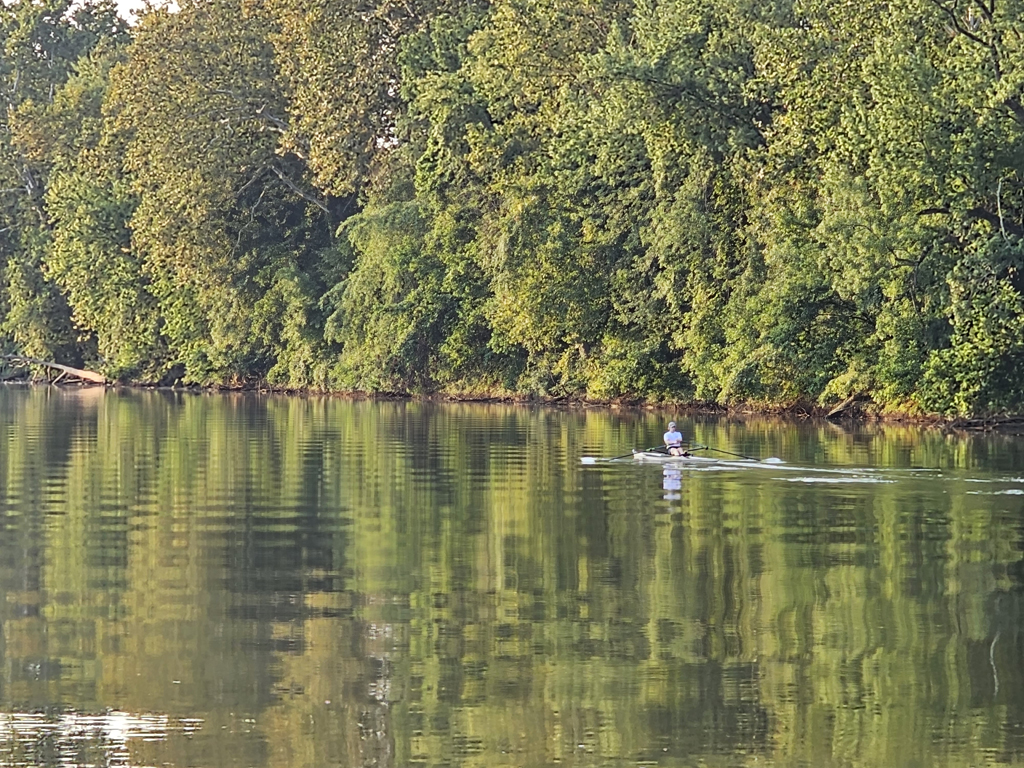
Indigenous cultures lived along the Ohio River for thousands of years. Some of them built large mounds, for purposes that are not fully understood, but are thought to be connected to cosmology and astronomical events. Moundsville is one location, and there are 3 large mounds in Marietta, known as Marietta Earthworks. 19th century settlers in Marietta preserved what was known as the Great Mound, by putting their cemetery around it. By 1900, the Mound Cemetery had the highest number of burials of Revolutionary War officers in the United States. At the close of the Revolutionary war, officers were given grants of land, and George Washington particularly favoured the Marietta area for land grants. The location of the town at the confluence of two navigable rivers, ensured its commercial success, and we can see from the beautiful old buildings downtown that this was a very prosperous city in the 19th century. Oil was first drilled in Marietta in 1860, and succeeding oil booms added to the wealth of the town. The longest running, and until recently the only, ferromanganese refinery in the United States is located in this city. Ferromanganese is used as a deoxidizer in the steel making process. We would have loved to be here for the Sternwheeler Festival, an annual event since 1976. As many as 35 authentic steam driven sternwheelers are expected to participate. We have noticed that there seem to be a lot more sternwheelers, both commercial and in private hands, on the Ohio River, than we saw last year on the Mississippi. Some have been lovingly restored, while some are just sad relics of a bygone age.

Dick enjoyed a day of exploration and a little grocery shopping, while I continued with the laundry. The man on the boat next to us came over to chat, very friendly, and offered us the use of his car.
Another pleasant dinghy ride took us to the courtesy dock at the foot of Harmar, the small town across the Muskingum River from Marietta. It is a well-preserved historic village, with some beautiful old houses and storefronts. One of the properties is occupied by someone with a sense of humour. Instead of a bottle tree in the garden, they have a bicycle tree, with a number of bicycles hanging from the branches.
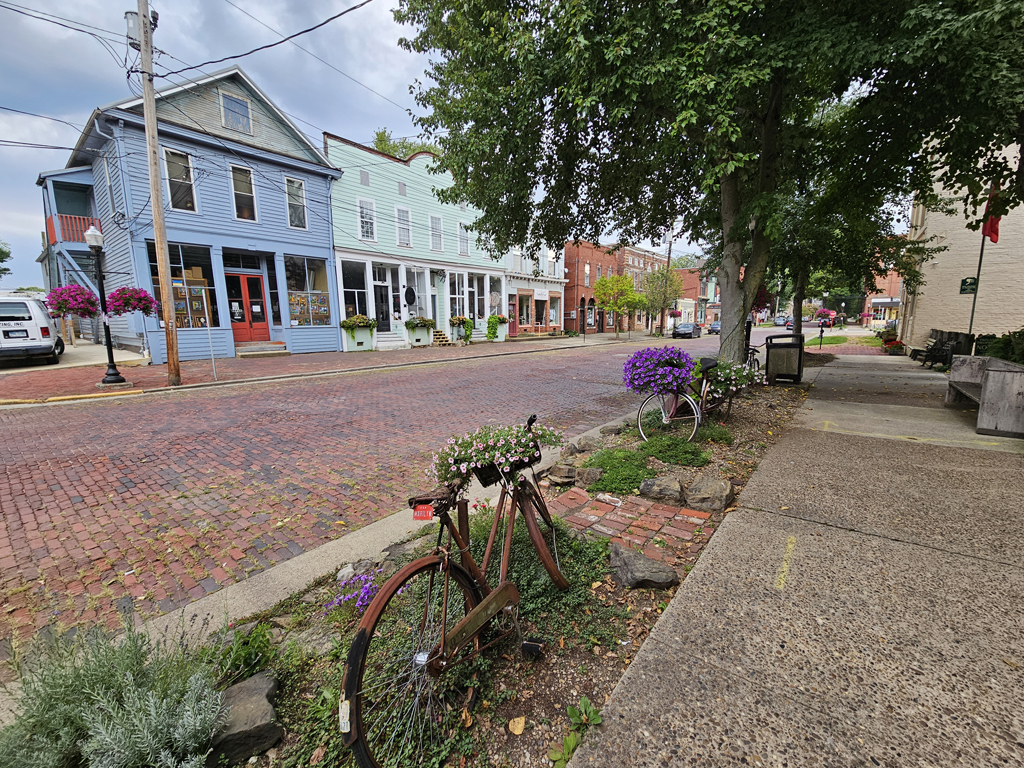



Spagna’s was a good meal. We shared pepperoni rolls and stuffed mushrooms. My lobster mac and cheese was improved by not having crumbs on top, but for my taste, there was not nearly enough sauce. Dick liked his lasagna. We shared a very tasty lemon cake for dessert. For a change from bubbly, I started the meal with a local Manhattan. It was a very generous pour (something that does not happen in UK, where the number of ounces in a drink is strictly regulated). In fact, it was such a good pour, that after that and a glass of wine, I felt decidedly merry. Not so much that I was at risk of an impromptu swim when we returned to the dinghy though.





We stopped to have a look at the Harmar Bridge. This was originally a wooden, covered bridge, constructed for use by pedestrians as well as horse and buggies by the Marietta and Cincinnati Railroad in 1856. 18 years later, rails were added, and it was converted to use as a railroad bridge. A swing span was added to the Harmar side in 1880, to allow larger boats to pass under it. Destroyed and reconstructed several times over the next 20 years due to floods, it was converted to an iron bridge in 1900. The Great Flood of 1913 took out all spans of the bridge except from the swing part, as well as the train that had been put on it to try to anchor it down against the floodwaters. The bridge was rebuilt, and some years later the swing section was moved to the Marietta side. Closed for rail traffic in 1968, the pedestrian walkway was left open until it became unsafe, and it was fully closed in 2020. Efforts continue to raise enough money to rebuild and preserve the historic edifice.

We enjoyed our stay in Marietta, although we could have wished for a less chaotic arrival and a more friendly welcome from other boaters, something we have enjoyed at several boat clubs on the trip so far.
It rained all night, and was still raining the next morning. That means wet lines, and my particular dislike, wet gloves. Disdaining his waterproof jacket, Dick filled the water tanks and retrieved the dinghy, and we prepared to cast off. I was glad to wear my jacket, plus a hat! Visibility was good in spite of the rain.
It was an uneventful day, with only a slight delay at the lock to allow a big tow to get into the main chamber. We anchored behind Buffington Island, where we stopped on our northbound trip, by 3:15. The owner of the land where we anchored stopped on his boat to chat. He was a nice guy, even offering us the use of his fully plumbed outhouse if we needed it!
I made shrimp sandwiches again for our dinner. Cooked shrimp are chopped and melted butter with crushed garlic is poured over them. A mixture of mayonnaise, Dijon mustard, chopped chives, celery, lemon juice, and lemon zest is then stirred into the shrimp and the bowl is chilled. The remaining garlic butter is brushed on the inside of the rolls, and they are toasted, and lined with butter lettuce and then the shrimp is added. We will definitely be making these sandwiches again.
Our night was mostly quiet and peaceful, but thunderstorms woke us at about 5am. There was little wind, but enough to turn us a full 360 degrees several times, as the current was not strong enough to hold us straight in the channel. We later learned that others had a pretty wild night, with strong winds and lashing rain, and some areas were without power by morning. Obviously, the island was a great place to have stopped. We were away before 8:30. The anchor came up easily, and the rain stopped.

We passed Blennerhassett Island, now a Historical State Park, served by an authentic sternwheeler ferry. The island was settled in 1789 by Harmon and Margaret Blennerhassett, wealthy Irish aristocrats who were fleeing what is described as political persecution and personal scandal. Call me cynical, but I suspect a lot more of the latter than the former! Their mansion became the headquarters for Aaron Burr’s military expedition to the Southwest in 1805. The Blennerhassetts fled the island when Burr’s treasonous plot collapsed, but the mansion remains. It has been reconstructed, and volunteers in period costumes show visitors around and describe what it was like to live there in its heyday.

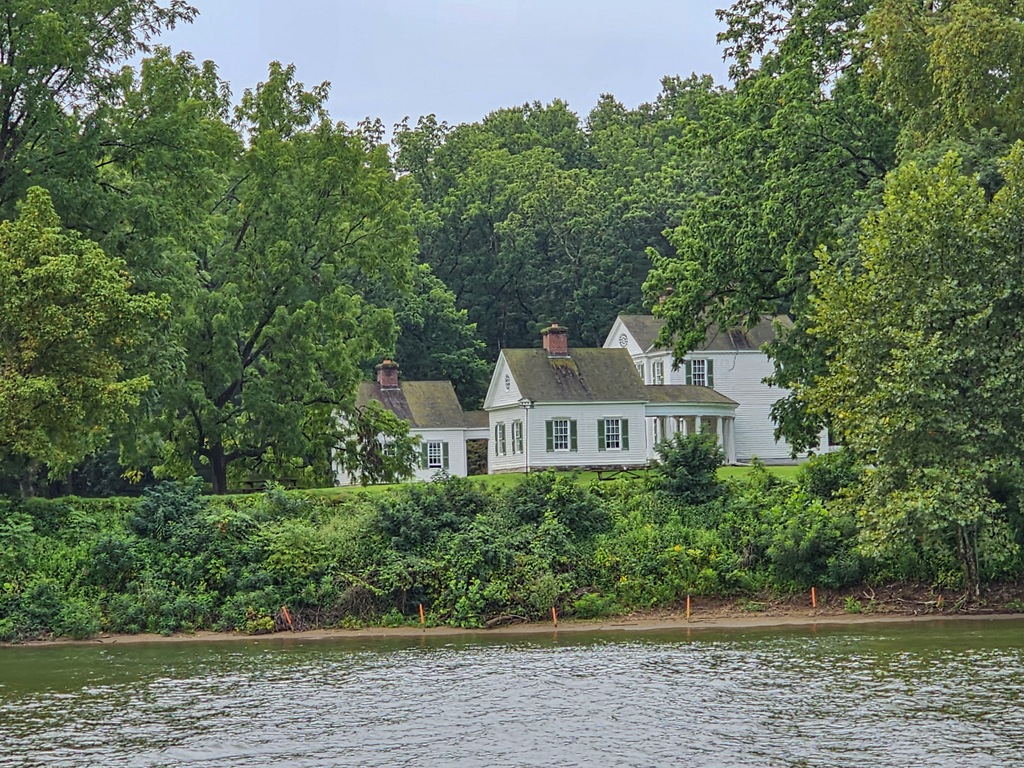
As we approached the lock, slowing down to allow a big tow to exit towards us from the big chamber, we saw that it was carrying an unusual load. It was a huge cylinder. We have no idea what it was, Dick is not prepared even to hazard a guess! Once we were in the lock, the doors took a long time to close. I suspect the lockmaster was allowing time for another tow to enter the large chamber. When it was finally time to exit, they only opened one gate. At this point I relinquished my position at the helm. Nine Lives fits through one door with space to spare, but I prefer not to be the one responsible in that situation!
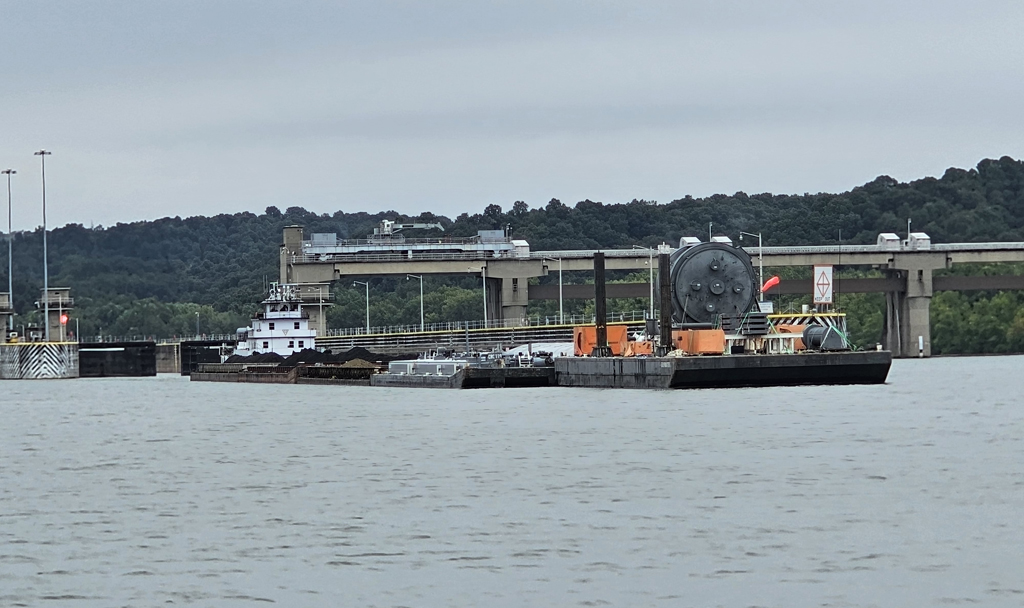

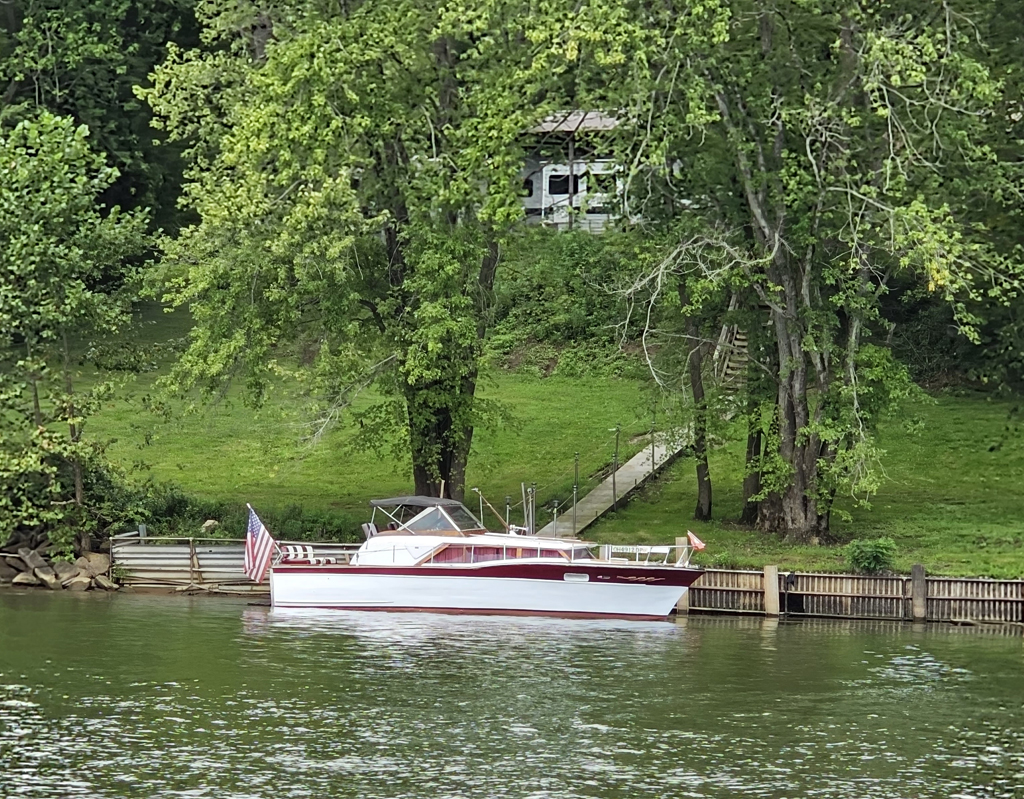
Steam from the Gavin Power Plant was visible for miles. It is the largest coal-fired facility in Ohio, and one of the largest in the USA. In 2002, to avoid lawsuits relating to air pollution, the operating company decided to buy out the residents of the nearby village of Cheshire, by offering 3.5 times more than the market value of their homes. The plant has been using unlined pits to store its fly ash, and was denied a permit to continue. In November 2022, it was ordered to stop dumping coal ash into the ponds, and speed cleanup of the site. This is such a big project that in order to comply the plant would probably need to be shut down. The company had 135 days to comply, but they were also allowed to present arguments against shutting down because of the effect on the grid.

Kyger Creek Power Plant is immediately next door. This plant is older, built in 1955 to service the Portsmouth Gaseous Diffusion Plant, a uranium enrichment plant. When that plant was shut down, the Kyger Power Plant had to begin selling its power on the open market. In 2019, customers of First Energy were ordered to pay extra to subsidize the plant. This scheme was part of a public corruption scheme revealed by the Department of Justice a year later. We could see that both plants are still operating, and while the steam coming out of the cooling towers looked appropriately clean, the smoke from the tall stacks was tinged with brown, suggesting that not all pollution mitigation measures are working as well as one would wish.

We tied up in the town of Gallipolis by 2:30, on a very good town dock, with even some rubber to preserve Nine Lives’ delicate hull. Dick had chosen a restaurant, but it was a bike ride away. When he went out for his usual recce, he discovered that this is the most bike-unfriendly town we have visited. There are no useful bike paths, and the streets are busy and lined with parked cars, forcing you to ride in traffic. Further investigation of closer dining options suggested that this would be a night to eat on board.
The history of Gallipolis is more about failure than success. It began with a group of 500 French aristocrats, merchants, and artisans, who were fleeing the French Revolution. They were sold land in Gallipolis along the Ohio River by the Scioto Company. On arrival, they discovered that Scioto Company had no right to sell the land, and their deeds were worthless. Eventually, the settlers were granted land nearby, but with a proviso that they had to live and farm the land for 5 years before they could sell it. They were city people, and not prepared for farming life in undeveloped America. Many of them had to buy the land they thought they owned from the Ohio Company in order to settle in Gallipolis. In 1967, the Silver Bridge, which I wrote about earlier, that connected Gallipolis to Point Pleasant, collapsed. The city is still a bedroom community, with employment at nearby power stations, healthcare providers, and universities.



We were visited by a man who had seen us on our northbound trip, and had looked us up online. I sent him a note that morning, and he stopped by to say hello. He didn’t have time to join us for a beer, but we did enjoy a nice chat.
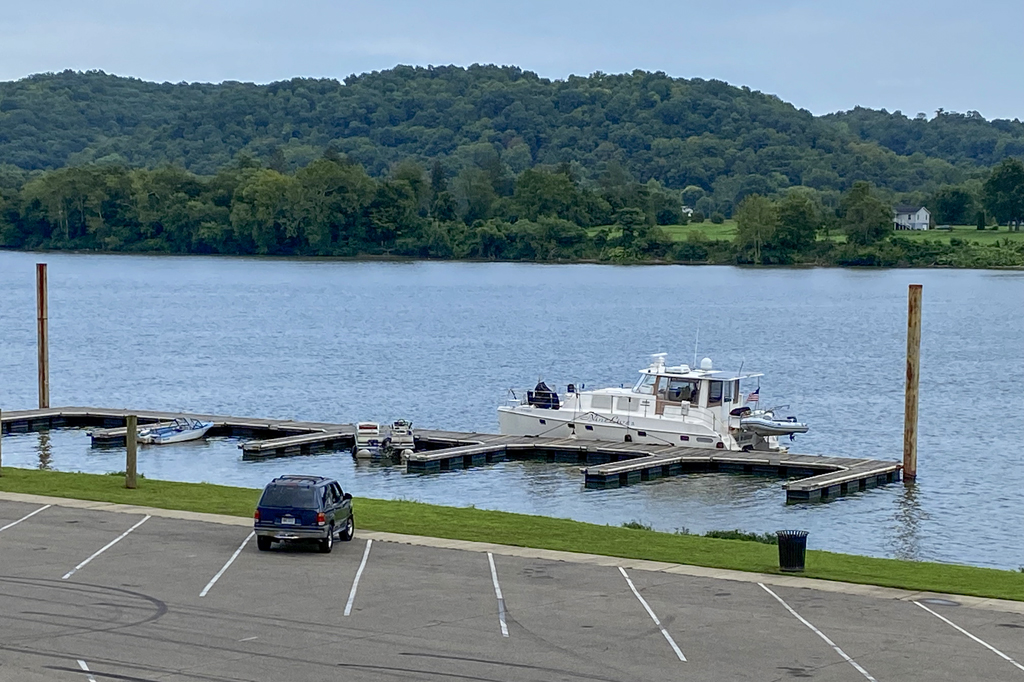
Once it started to get dark, I felt the least safe of any of our free docks so far. There were a great many young men driving up and chatting with each other before driving away again. Dick tells me that not everyone is a criminal or a drug dealer, and I guess in a small town, there are limited options for the young on a Friday night, but I was not very happy. All was well however, nobody bothered us, and it was a quiet night apart from rocking from occasional tows. The next morning there was a town employee picking up rubbish in the parking lot, even though it was the weekend – more towns should do this! Later, a group of ladies gathered and seemed to be enjoying themselves in a Zumba class.

After a big breakfast, we were underway by 9:30 for a short journey to Huntington. The drop in the lock was considerably less than the expected 23’, and below the lock we could see that the trees at the edge of the banks were in the water. There was also almost 2 knots more current than the previous day. All this would have been the aftermath of Thursday’s big storm.

We docked in Huntington by 2:30pm. This time, we went for the lower, upstream wall, where there were good cleats (the downstream wall we had docked at before had widely spaced bollards). It was very shallow, to the extent that the depth finder stopped registering, but docking was made easy by a fellow boater who caught the lines. There was a festival going on, so we had a big audience. Both the boater who caught our lines, and another one who tied up later, warned us that it was shallow, but Dick felt that with the higher water we would be fine.
Huntington is the second largest city in West Virginia. Federal money for urban renewal in the 1970’s resulted in the tearing down of many of the beautiful old downtown buildings, and replacing them with ugly concrete boxes. An attractive downtown shopping centre is quite lively, with many shops and restaurants, but another effort to convert an old railway station to a venue for artisans and coffee shops has not been a success. The Huntington greater metropolitan area spans 3 states and 7 counties. I read that the port, called The Port of Huntington Tri-State, is the second busiest inland port in the United States. Industries include coal, oil, chemicals, and steel. The city’s beginnings were rooted in the railway business, from its beginning as the western terminus of the Chesapeake and Ohio Railway. The railroad expanded east, and west, and after several mergers, it is now CSX Transportation. Huntington was the second American city to use electric streetcars. Today, the largest employers include Marshall University, a hospital and medical centre, Amazon, and Direct TV, as well as the City itself.
We had a wonderful evening. We booked a meal at 21 The Frederick, a historic hotel that has been sympathetically converted to luxury rental apartments. We wandered around the lobby and admired the beautifully preserved period surroundings. This is the top fine dining restaurant in Huntington. The restaurant décor was an interesting mix of styles, some clearly dating from its heyday in the early 20th century, some definitely a 60’s unsympathetic makeover, and there was a most extraordinary frieze of golden elephants, of undetermined vintage, around the edge of the room!



Our meal was excellent, the best since Pittsburgh. It is clearly a venue for special nights out.




Those of my readers who wish to avoid social commentary should now avert your eyes for the next paragraph.
For some time, Dick and I have noticed that some of our generation, many of generation X, and almost all of the next groups seem to lack any sense of respect for the standards of dress for fine dining restaurants. Not the women – they clearly still enjoy the chance to dress up. No, it is the men who continually let the side down and show a complete lack of respect for the establishment, the staff, and the chefs, who go to a lot of trouble to create and present a special night out. Not to mention their dining companions. The US is not the only place. We have seen it in Europe, the Mediterranean, and Britain. However, there is something uniquely North American (yes Canada, you are right up there in this too), in the concept of shorts, t-shirts, and baseball caps as reasonable attire for a fine dining restaurant. On this occasion, there was a group of 12, seated across from me. There were 9 women in the group. Every one was dressed up, and I would say the older lady even had her hair done for the occasion. Of the 3 men, one was very metropolitan sophisticate, but the other two were what we see again and again. Tight cotton t-shirts, baggy cargo shorts, and baseball caps that were not removed. To be fair, one of these men held the chair for his lady. It is a sad lack of respect for appropriate social norms. I suppose some might suggest that these are new social norms. And here endeth the rant.


August 27th. There was rather more excitement in the morning than we wanted. As we had our first cup of coffee, I realized that we were not floating. A leisurely start had been planned, with only a 2-hour trip that day, but we decided to abandon any thoughts of more coffee or breakfast, and see how bad the problem was. We were free at the bow, but firmly aground at the stern. Dick is strong, but he couldn’t push us off. The dinghy adds about 300 lbs to the stern, so we dropped it into the water and brought it alongside, giving us about 2 more inches. With some unpleasant noises from protesting props, Dick managed to wiggle us free. We then put on life jackets in case of mishap, and floated in the middle of the river to bring the dinghy back in and up onto its davits. Ultimately, we were underway by 7:30am. At least the local boaters had left the night before, so we did not have the humiliation of either an audience or an “I told you so”.
Lessons learned – when the depth gauge shows no water below the boat, believe it and back away. When local boaters advise against docking, believe them. When potential problems can be avoided by repositioning, do it, even though it is a big pain once you are set and tied up.
Two hours later, and with no locks to transit, we arrived in Ironton, and tied up at their great floating dock (with plenty of depth).
Ironton began as a centre for the iron industry in 1849. Between 1850 and 1890, it was the biggest producer of iron in the world. At the peak of production, there were more than 90 furnaces in operation, producing high quality iron that was used for warships as well as other industries. When the transition was made away from iron and toward steel, the city lost its economic base. The city has tried hard to attract other industries to the area, but the initiatives were not successful. Ironton is notable for having one of the first professional football teams in the United States. In the early 1930’s, the team was amalgamated with another local team, and was moved to Detroit, renamed the Lions.
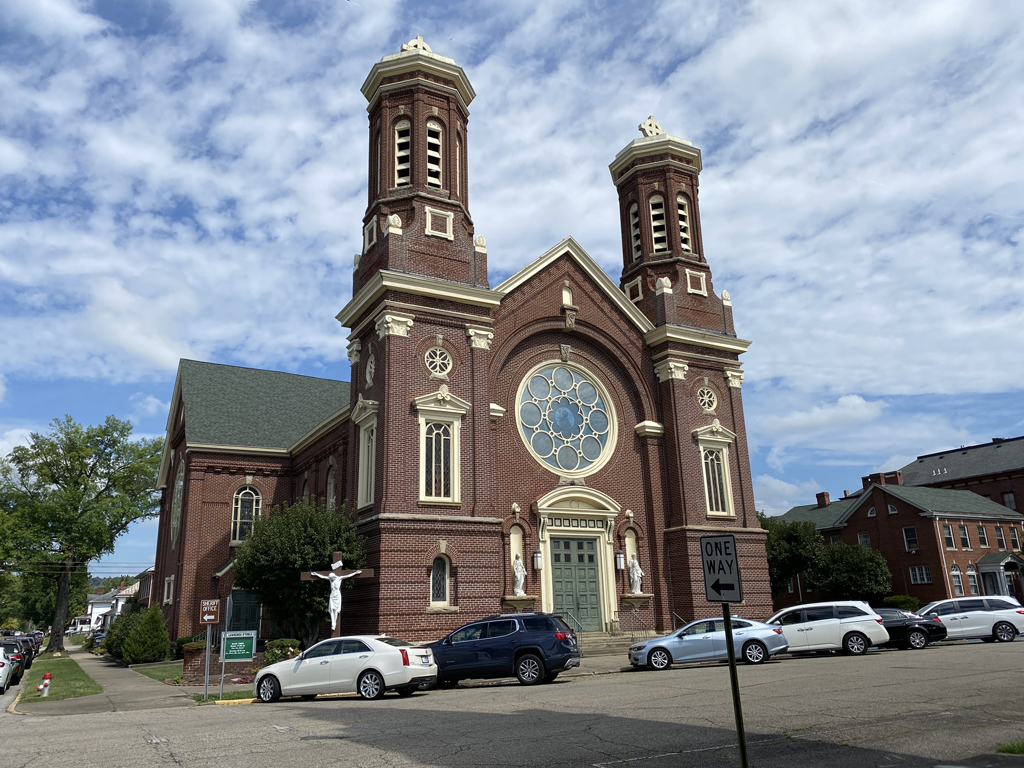
The restaurant we had planned to eat at was closed on Sunday. It looked interesting, as it was in an old railway depot. Instead, we went to a local Italian restaurant. Dick liked the food, I did not. Either that makes me a picky eater (Dick’s verdict), or more discerning than my beloved. The first surprise was being told that, as it was Sunday, there could be no wine or cocktails, but beer was okay. That seemed strange, but as Dick said, blue laws tend to be strange anyway. I looked it up. In Ohio, you can serve beer on Sundays without a special license, but for intoxicating beverages (that would be wine and spirits), you need a special license. Who decided that beer is not intoxicating??
Later in the evening a houseboat tied up on the dock below us. In the morning, Jim came along the dock and introduced himself. We had a very pleasant chat. He was taking an elderly, but new to him, houseboat north to Marietta and up the Muskingum to his home. We don’t envy him single-handing through all those manual locks! After a big breakfast, we were on our way by 9:45.
Hanging Rock is a town just south of Ironton. In addition to being known for giving punishing speeding tickets to unsuspecting visiting motorists, it is the location of a former iron mine that had particularly high purity iron. The Hanging Rock Region produced some of the best iron in the United States between 1818 and 1916. The rusted old loading facility is visible just downstream.


Our next stop was a return to the Shawnee Boat Club in Portsmouth. It’s a strange and difficult dock to tie to, set up with small eyebolts with a rusty cable running through them, along the edge of the dock. On our last visit, the dockhand came down and helped us, but he was mowing the grass and did not bother this time. Dick says the system is easier for small boats, especially pontoon boats, but it is a royal pain in the you-know-what for bigger boats. I couldn’t get a boat hook under the cable from above, so Dick had to get off the boat and take the lines off the deck while I held it steady. The system, including the water lines, also create a nasty tripping hazard right at the edge of the dock. Not our favourite stop, but after 4 nights without, we needed water.

The Shawnee Boat Club is located in Portsmouth. Although I can find no other records of it, a plaque tells us that there was once a canal that ran from Portsmouth north to Cleveland. The Ohio and Erie Canal was built between 1825 and 1832. Boats leaving Cleveland had to climb 500 feet to get to Newark, and then descend 500 feet to Portsmouth and the Ohio River. There were 55 locks on the descending stretch alone. Although there are the remains of a few of the locks, there is no longer any trace of the canal.

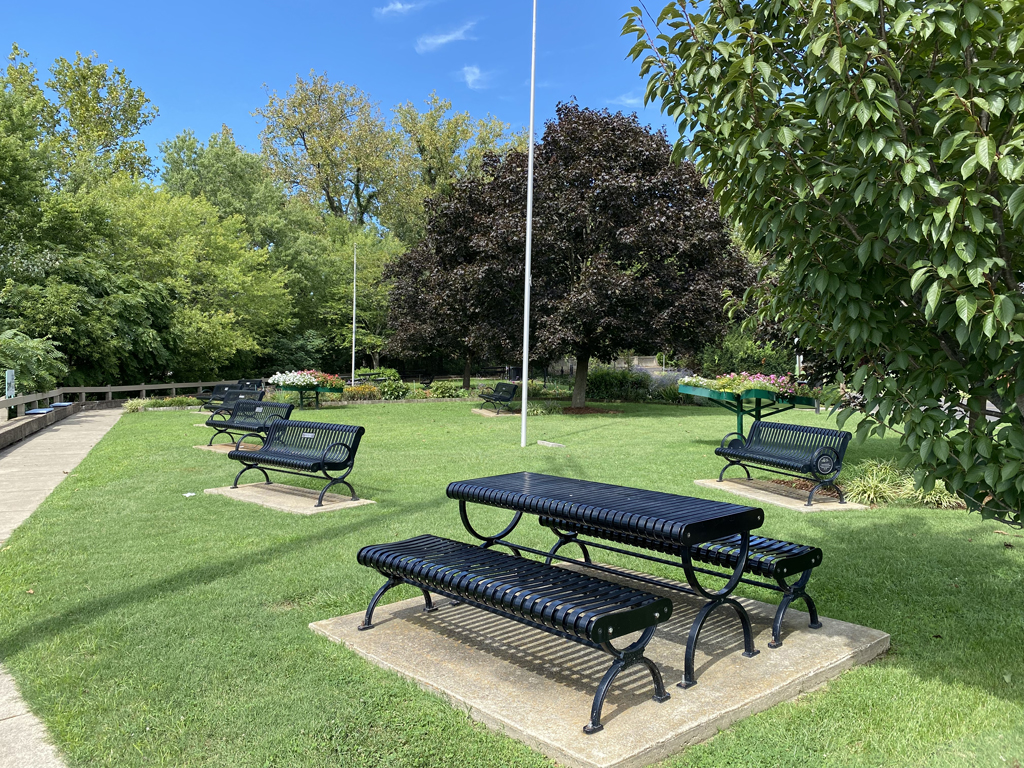


It was a day with an early arrival and no plans to eat on shore, so I was able to try a new recipe, pork fricassee with mushrooms and artichokes. The first challenge in preparation, was finding that I don’t have a meat mallet on board, to pound the pork pieces into ¼ inch medallions. Being an intrepid cook, I borrowed Dick’s hammer. Once wrapped in two layers of foil, it worked very well. I just had to be careful not to hit too hard, or the head of the hammer would go right through the meat! The dish turned out very well, and was delicious, definitely a keeper. Afterwards we sat in the cockpit and watched the sun set with a postprandial glass of bourbon, since we have left West Virginia and are now back in Kentucky.

We are seeing more eagles on this stretch than we did on the upbound trip, both mature and juvenile bald eagles, although not as many as we saw on the Mississippi. The wide Ohio River makes it hard to see them unless they fly across, and photographs are out of the question. Considering that bald eagles had disappeared from the Ohio, along with herons and other large birds, this is a good sign.
We tied up at Ripley Boat Club before 3:30. It had been a 60-mile day, but with no locks to delay us. The Boat Club has a long dock with a restaurant. The dock has nice big cleats, freshly painted, so there is now a little blue decorating our black lines. A first time for us, the wooden docks have old tires on the sides, and boats are protected from the black rubber by tarps hanging over them.
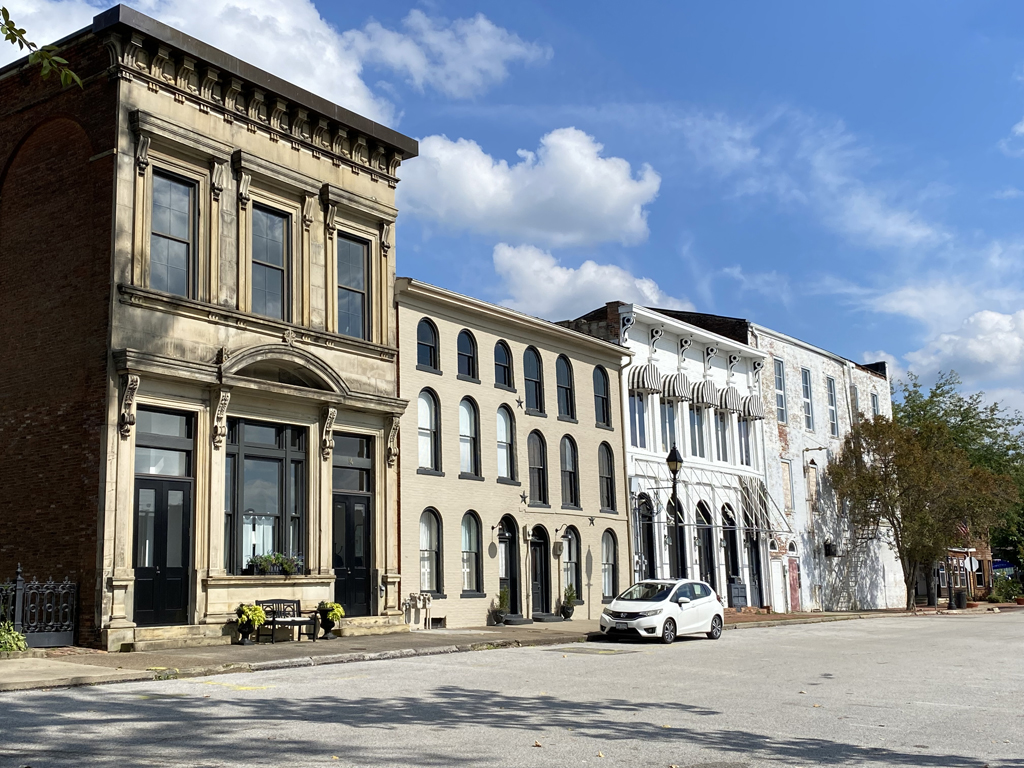

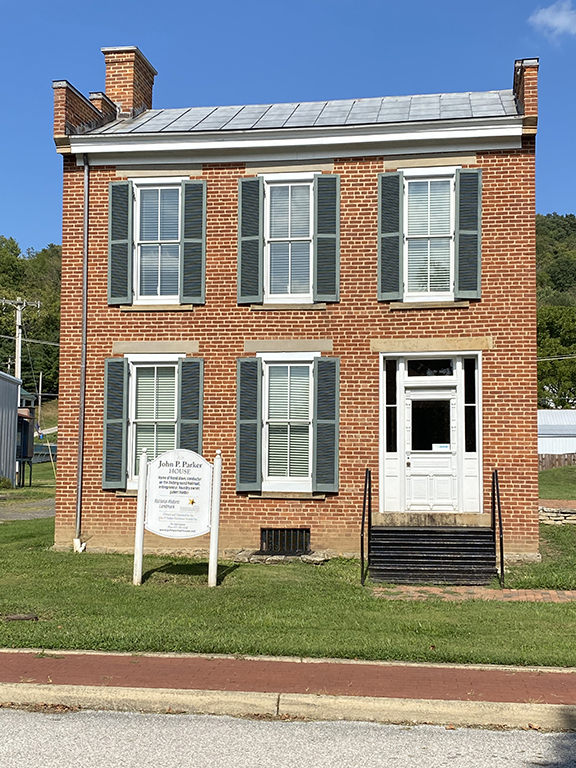
The restaurant was very popular, but we had already decided to eat on board, and basket food and burgers were not enough to tempt us. There was some noise from trains across the River, and a few wakes from tows, but it was a mostly quiet night.
August 30th. We chose an early start, and were out by 8:10, with a lot to do on arrival in Cincinnati and one lock for the day.
We were put through the big chamber, and there is always a bit more motion in that circumstance, but Nine Lives likes going down, so we just swung gently back and forth on the floating bollard at midships, while the fore and aft fenders kept nudging us off the walls. As the gates opened, we saw an opportunistic heron, standing in the gate door, ready for any fish that might be hanging around inside the lock. He watched as we approached, critiquing our lock exiting technique.
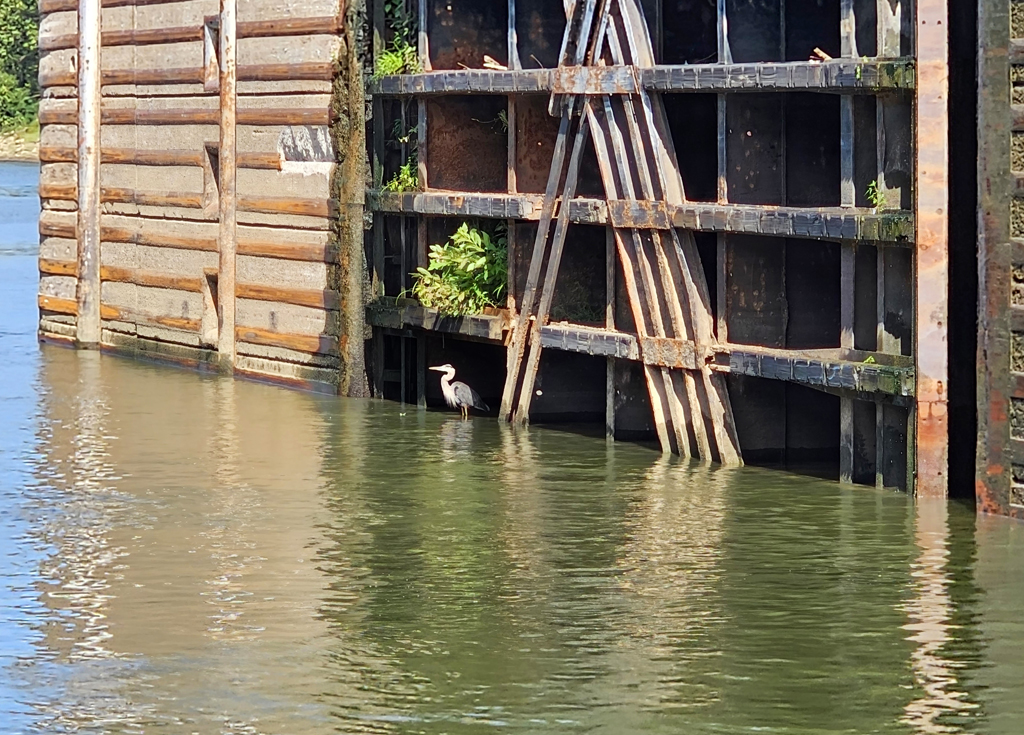
Down the river, we saw a barge being loaded at a lime operation. We find it hard to believe that the barge doesn’t sink the way they are loaded!
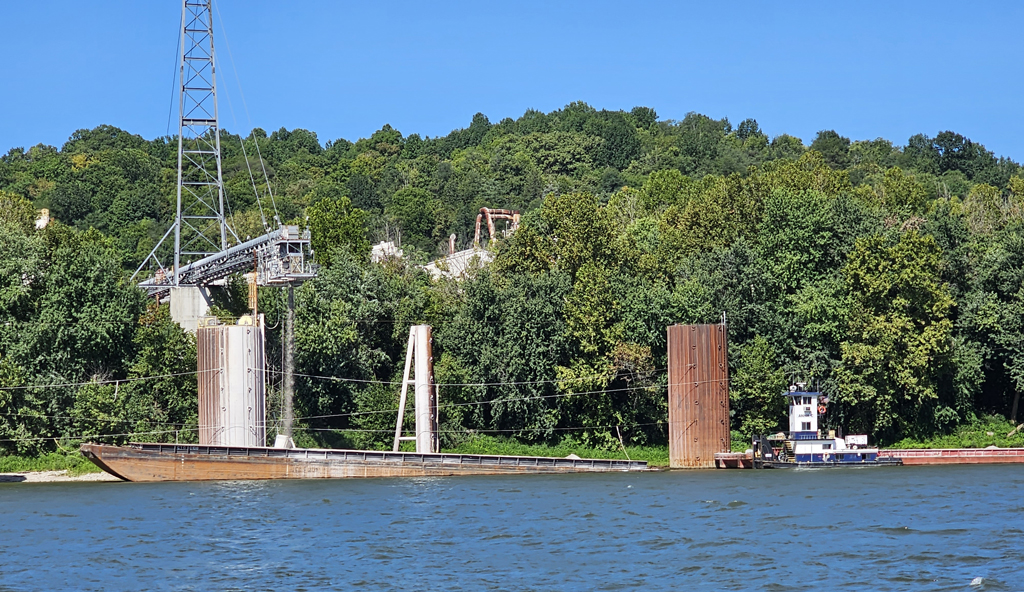
Approaching Cincinnati, we passed a still under construction French chateau, and later a beautifully landscaped Moorish-style villa, both high on the hillside with stunning views.



We were in the marina by 1:15, but stopped for a pump out first. Tied up and all set by 2pm. It was disappointing to find goose poop on the end of our finger pier, staff at the marina should clear it off when a boat is coming in with a reservation. It was nothing like the messes at South Side though, and Dick quickly got rid of all of it as he prepared to fill our water tanks.
Dick collected the rental car we had reserved for our stay in the city. While he was doing that, another boater dropped by to admire Nine Lives. After he learned that we would be here over the weekend, he kindly offered to lend us his car. This is easily the 5th or 6th time strangers have made this offer! In Canada, only close relatives typically lend vehicles, and in UK, you have to call your insurance company and add the additional driver before you can lend. However, in the US the insurance is more agreeable.
We had an interesting dinner at a Hungarian restaurant. Having lived in Eastern Europe, we like Hungarian food. We tried a local specialty, Goetta, a pork sausage made with steel cut oats. These were quite spicy. I liked the taste, but not the texture. For his main course, Dick had a combination plate, so he could try their cabbage rolls, goulash, and Hungarian schnitzel. I had an interesting version of Wiener schnitzel with poutine. The schnitzel, gravy, and melted cheese curds were excellent, but as so often happens, the French fries were not very good. Our desserts were delicious.




We looked for the super blue moon, and eventually found it, but from our location on the boat, it was basically a non-event. We would have had to drive somewhere to view it at its best.
All day and evening, we watched the progress of Hurricane Idalia. Our kind neighbours in Hilton Head took in our balcony furniture for us, as Kathy was out of town. One positive thing that happened, at some point there must have been a brief power outage, because our router was reset. It had stopped working a few days earlier. So I now have my security camera back online and can see what happens in our apartment.
August 31st. In the morning, we went to Findlay Market, probably the best market we have visited since Ottawa, several years ago. There was a wonderful cheese shop, and we also picked up some treasures of the foodie kind in an international food shop.


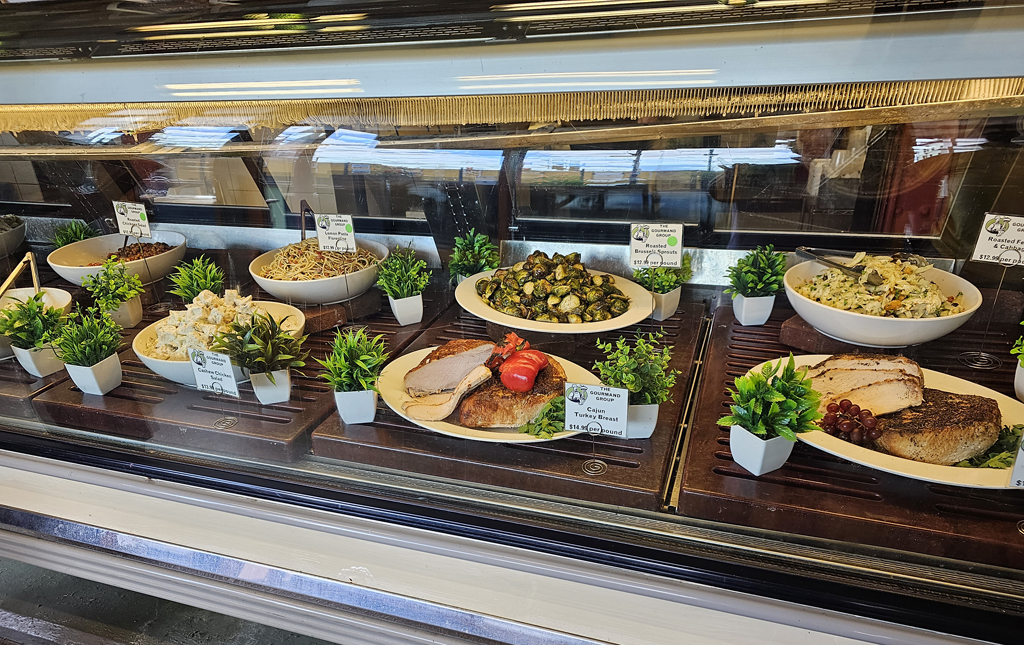
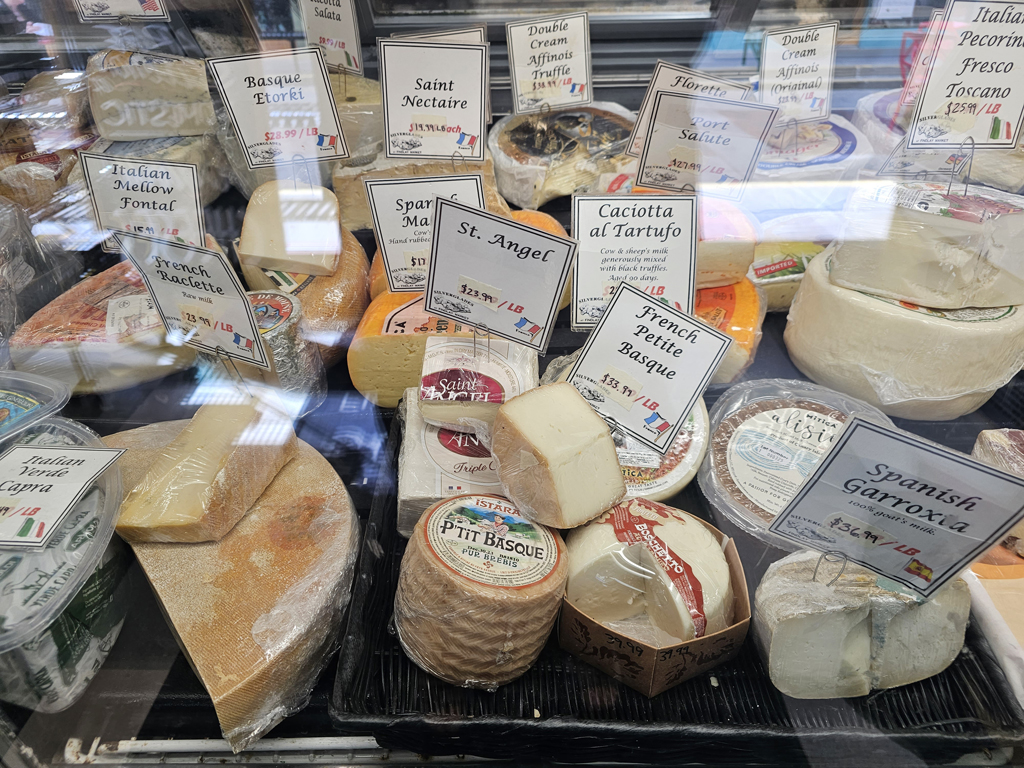
In the late afternoon we hosted a most enjoyable docktails. Our guests were Audrey and Ted, truly Looper royalty, who completed their loop in 1998, and still participate regularly in AGLCA events. Ted is also involved with two of the most useful guides for the waterways, Waterway Guide, and Skipper Bob. As a complete contrast, Mike, who also joined us, will start the Loop next week. He and his wife Darlene hope to drop by for some more chat and advice on Saturday. It was an evening with lots of great stories and some good laughs, a great time.


We had been aware of huge delays at one of the locks further south on the Ohio. The large chamber is under repair, and all boats are being put through the small chamber. This requires most tows to split, and go through in two halves, turning what would usually be a one-hour lift or drop, into a minimum of 3 hours for each tow. Also, tows have to avoid each other, so the queue has to be well stretched out. The lock has been reporting delays of as much as 60 hours (yes, six zero), for tows in the queue. Dick called the lock, and explained that we were planning to come through in about 10 days, and asked what procedure we should follow. He was told that no recreational boats would be put through the lock until November. This gave us a couple of days of concern and thinking about options. Fortunately, it seems that the person Dick spoke to, made the assumption that he was a fisherman, and they are indeed refusing all small fishing craft until after work is completed in November. However, we have been advised that yachts, such as ours, will be accepted, and there is a procedure to follow. We will need to call ahead, and make an appointment for a specific time. Since locks operate 24 hours a day, there is a good chance we may be on the River during nighttime hours, something we prefer to avoid. So that is the cliffhanger, the story to be told in the next issue of the blog!
